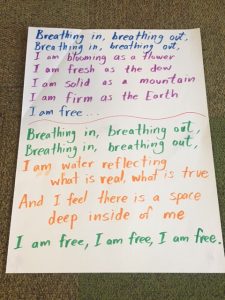The goals of meditation can vary from practitioner to practitioner. A practitioner may meditate to calm themselves, regulate emotions or reduce stress. They may also engage in meditation as a strategy for deep reflection, connection or intuiting. In its traditional form, it is practiced by sitting still and focusing on the breath or bodily sensations. This traditional practice shows up in Rainbow classrooms and centering practices but just as the goals of meditation vary, so can the form it takes.
At RCS, meditation takes on many shapes and often engages various learning domains. Creative meditation, for example, is explored through expressive ways such as mindful drawing or writing. Students may also embody a kinesthetic meditation by mindful walking, yoga or interpretive dance. Additionally, solo time communing with or observing nature attends to the natural domain.
Meditation at Rainbow, regardless of form begins by slowing things down, bringing awareness to the body and aligning each activity with the breath. The rituals of a 2nd grade centering often begin with a gentle reminder from their teacher, Eddy, to still their bodies, hold a silence for the candle lighting and three deep communal breaths. Eddy also recognizes the boundless physical, mental and emotional benefits of collective singing and to that end, it too has become part of these cultural rituals. Ultimately, communal singing in this reverent and celebratory way has become a meditation for these students. Simple melodies paired with profound lyrics aim to deepen the already sacred tone, nurture a transcendent experience, strengthen their bond and invite a bit of whimsy.

On this day, once the centering rituals are complete, Eddy begins describing the meditative drawing activity the students will be participating in. He explains that they will be using shapes and forms to create a collaborative sculpture, meditate on it and then draw what they see. He explains that the goal is to bring mindfulness to their observation and their drawing skills.
He invites the students to choose a three-dimensional shape from the tray and then asks them to place their shape on the silk that covers the center of the rug. This communal creation resembles a city of sorts. He prompts the kids by saying “imagine walking through this world. Let your imagination allow it to come alive, look at it from all angles, what do you see, what is around you…meditate on it.” He then rings the singing bell and tells them that when they can no longer hear the song of the bowl that will serve as their signal to begin drawing.
Eddy emphasized to the kids to just… draw what they saw. Those simple words became so freeing for the kids. Those words evoked a sense of autonomy that set the stage for a pure meditation. They were able to fully embrace the practice- free from perfectionism, free from concern for mistake making or being right over wrong. The tone of the classroom settled into a calm inquiry, a collective focus, and a creative meditation.
How can your traditional meditation practice take on a new form? Try something different today? Mindful eating, tea meditation, deep listening, walking meditation…
Make a list of 5 daily activities that you can bring some mindful presence to and take a pause for those each day. Try it for a week. What do you uncover or discover? REFLECT.








